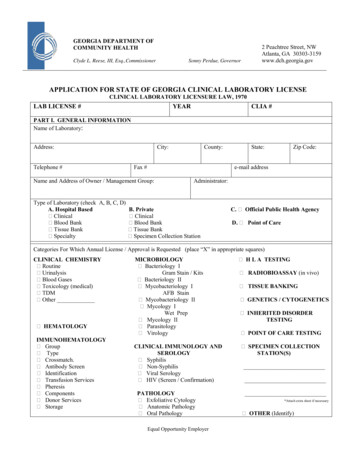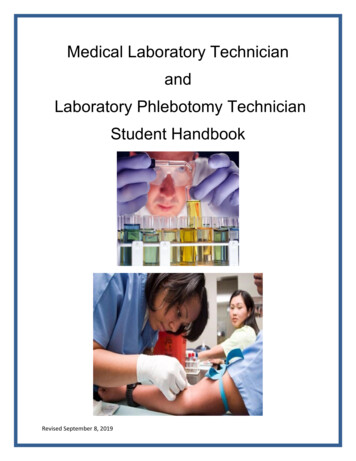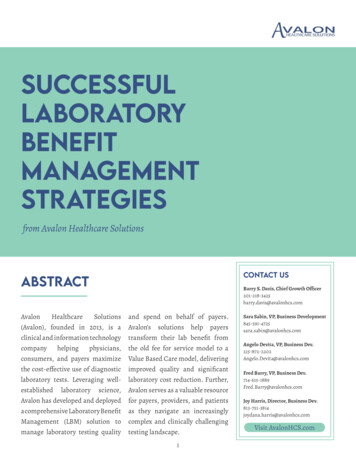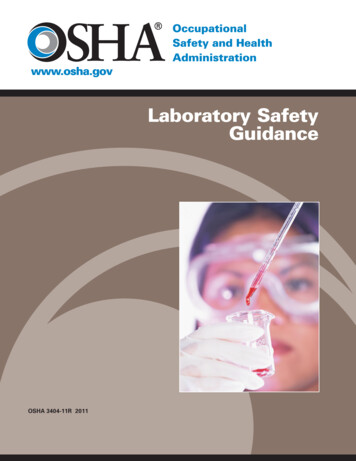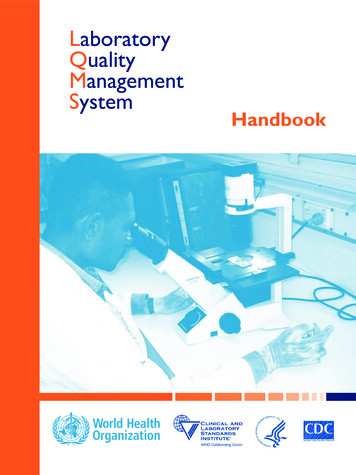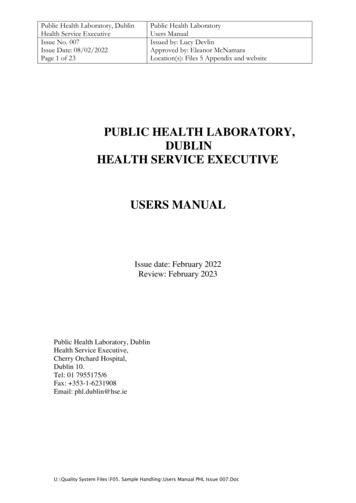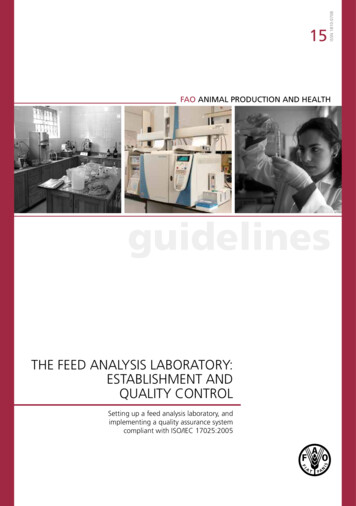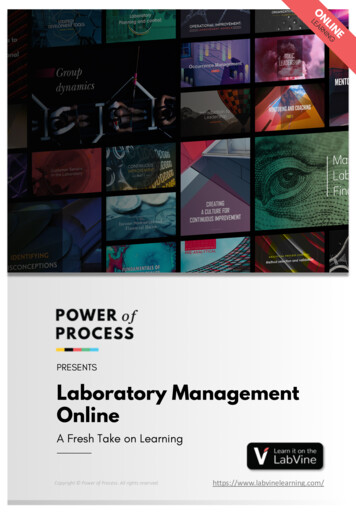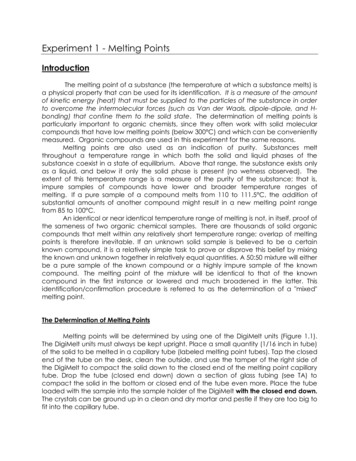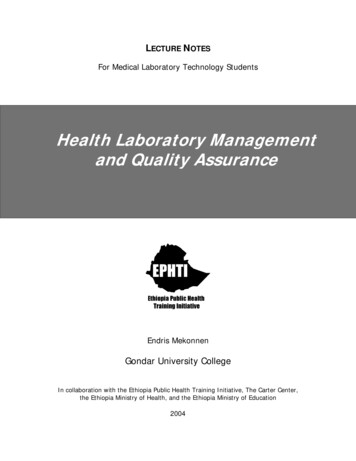
Transcription
LECTURE NOTESFor Medical Laboratory Technology StudentsHealth Laboratory Managementand Quality AssuranceEndris MekonnenGondar University CollegeIn collaboration with the Ethiopia Public Health Training Initiative, The Carter Center,the Ethiopia Ministry of Health, and the Ethiopia Ministry of Education2004
Funded under USAID Cooperative Agreement No. 663-A-00-00-0358-00.Produced in collaboration with the Ethiopia Public Health Training Initiative, The CarterCenter, the Ethiopia Ministry of Health, and the Ethiopia Ministry of Education.Important Guidelines for Printing and PhotocopyingLimited permission is granted free of charge to print or photocopy all pages of thispublication for educational, not-for-profit use by health care workers, students orfaculty. All copies must retain all author credits and copyright notices included in theoriginal document. Under no circumstances is it permissible to sell or distribute on acommercial basis, or to claim authorship of, copies of material reproduced from thispublication. 2004 by Endris MekonnenAll rights reserved. Except as expressly provided above, no part of this publication maybe reproduced or transmitted in any form or by any means, electronic or mechanical,including photocopying, recording, or by any information storage and retrieval system,without written permission of the author or authors.This material is intended for educational use only by practicing health care workers orstudents and faculty in a health care field.
PrefaceIt is apparent that a well-managed health laboratory with anappropriate quality assurance program has a major role inenhancing the standard of health service delivery to thecommunity. Textbooks on laboratory management and qualitycontrol for students of medical laboratory technology are rarein most teaching institutions of the country. This lecture notehas been produced to help alleviate the severe shortage oftextbooks and reference materials on this topic. It is alsohoped that the material will be used by those responsible forthe management and organization of health laboratoriesbesides the contribution it provides in the training of laboratorystudents. This is not meant; however, to replace textbooks orother teaching materials, it is rather an aid with the existingtextbooks and references. The lecture note includes a total ofeight chapters on the management and organization eprograms.The author is very happy with any constructive comments,suggestions from users of this material.i
AcknowledgementI would like to acknowledge The Carter Center, USAID for thefinancial and material support, which was very important forthe preparation of this lecture note. My appreciation also goesto all teaching staff of the Departments of Medical LaboratoryTechnology and Microbiology and Parasitology, GondarUniversity College (GUC).Special thanks are due atory, GUC)Ato Biniyam Mathewos (Department of Medical Laboratory,GUC)Ato Aregawi Yalew (Department of Medical Laboratory, sitology, GUC)Ato Tesfaye Bekele (School of Med Laboratory Technology,Jimma oryTechnology, Debub University)W/o Selamawit Debebe (School of Medical valuablecomments and suggestions during review of this lecture note.ii
I am also very much pleased to extend my thanks to Dr.Seyoum Taticheff and Dr. Abera Geyid to critically review,comment and enrich the material with their high expertise inthe field of medical laboratory sciences.Acknowledgement is expressed to all those who lend theirhands in one-way or another for the betterment of thismaterial.iii
Table of ContentsPrefaceiAcknowledgementiiiTable of ContentivList of AbbreviationviiCHAPTER ONE: INTRODUCTION TO1MANAGEMENT1.1.Definition and General Principles1.2.Concepts of Management1.3.Function of ManagementCHAPTER TWO: HEALTH LABORATORYMANAGEMENT2.1.Definition and Principles2.2.Role of Laboratory in Health Care and Trainingof Laboratory Personnel2.3.Code of ConductCHAPTER THREE: tion of Health Laboratory Service inEthiopiaiv
3.3.Structure and Function of Laboratory Service inEthiopia3.4.Safe Laboratory DesignCHAPTER FOUR: EFFECTIVE COMMUNICATIONIN THE LABORATORY4.1.Communication4.2. Guidelines for Effective CommunicationCHAPTER FIVE: LABORATORY POLICIES5.1.Definition and Purpose5.2.Laboratory Hours and Emergency Work5.3.Range of Tests to be Performed and Referralof Specimens5.4.Work Load Capacity of the Laboratory5.5.Collection of Specimens5.6.Delivery of Reports5.7.Reporting of Results and Record KeepingCHAPTER SIX: MANAGEMENT OF LABORATORYRESOURCES6.1.Management of Time and Space6.2.Management of Equipment and Suppliesv
CHAPTER SEVEN: SAFETY IN THELABORATORY7.1. Importance of Safety7.2. Source of Laboratory Hazards7.3. Safety Measures7.4. Preventing Laboratory Infection7.5. Elements of Laboratory Safety ProgramCHAPTER EIGHT: QUALITY ASSURANCE8.1. Introduction8.2. Definition and Purposes of QA8.3. Components of Quality AssuranceCHAPTER NINE: QUALITY CONTROL10.1. Definition10.2. Types of QC10.3. Assessing Value of TestsGlossaryBibliographyvi
Abbreviations1. EQA- External quality assessment2. EQC- External quality control3. IQC- Internal quality control4. Lab- Laboratory5. MBE- Management by exception6. MBO- Management by objective7. NPV- Negative predictive value8. PER- Planning, Executing, Reviewing9. PHC- Primary health care10. PIE- Planning, Implementing, Evaluation11. PV- Predictive value12. PPV- Positive predictive value13. QA- Quality assurance14. QC- Quality control15. SOP- Standard operating procedures16. TQM- Total quality management17. VDRL- Venereal Disease Research Laboratoryvii
CHAPTER ONEINTRODUCTION TO MANAGEMENTLearning ObjectivesAt the end of this chapter, students are expected to:-Define management-Describe the basic principles of management-State the function of gementMany definitions exist to indicate what management is. HenriFayol, in the early twentieth century, defined it as the ding,coordinating and controlling’. E.F.L Brech called it ‘the socialprocess of planning, coordination, control and motivation’.Writing in the 1980s Tom Peters defined it as ‘organizationaldirection based on sound common sense, pride in theorganization and enthusiasm for its works’. It is clear thatmanagement is partly the process of getting things donethrough people; and partly the creative and energetic1
combination of scarce resources into effective and profitableactivities and the combination of the skill and talents of theindividuals concerned with doing this.Management is conducted in organizations. A context mustbe established.Organizations are variously described as:‘systems of inter-dependent human beings’ (D.S. Pugh); ‘ajoint function of human characteristics, the task to beaccomplished and its environment’ (H. Simon). Organizationsmay be seen as combinations of resources brought togetherfor a purpose; they have a life and a permanent identity oftheir own; and are energized by people.Principles of ManagementWhat are the commonest management principles?There are a number of principles of management and thefollowing 11 are the commonest ones.1. Principle of management by objective (MBO)Every activity of a given organization must have an objective.This objective, which could be qualitative or quantitative,should state:-What is to be accomplished-How much of it-How it is to be done-When it is to be completed2
Clear statement of the objective speaks it possible to evaluatehow effective one is in approaching and reaching theobjective. There are five important characteristics of objectiveand are known as SMART.1. Simple: Objective should be clear and understandable tothe health team. A familiar maxim, “If you do not knowwhere you are going, even you do not know where yourdestination is” works here.2. Measurable: in terms of quality and quantity for twoimportant reasons:i.To monitor the day to day activity (assessment ofperformance)ii.To help evaluate the activities (for the future course ofaction)3. Achievable: Feasibility is an important criterion for goodplanning. Objective should be something that can bereached at; it should be realistic.4. Relevant: All action plans should be directed to the majorproblems of that community. The objective shouldaddress the real problems of the community.There are two kinds of approaches when talking of relevance:i)Felt problem: What the community has sensed as majorproblem.ii)Real problem: what the planners (health workers,professionals) identified as a problem in that community.3
It is, therefore, important that health professionals identifythe felt needs of the community.5. Time bound: Time should be a common denominator forall objectives. It should have a time frame like this: EPIcoverage of X district should go up from 35% - 60% within5 yrs.Effectiveness is the degree to which a stated objective isbeing achieved; it is something that management tries toimprove. At the end of all the activities achievement iscompared with the objective, i.e. evaluation is done. Thishelps us to judge how effective our management was and toplan for the future course of action.Under achievement (negative)Å Objective ÆOver planningOver achievementUnder planning2. Learning from ctiveness. It is directly or indirectly dependent on MBO.When a gap occurs between objective and achievement orresult, management makes analysis of how the observedresults are achieved and discovers what causes the gap. Inthis process learning can take place. This process is4
sometimes called feed back of information from experience todecision for action.3. Division of LaborThis is the principle of specialization that maintains that workshould be distributed among members of a group. Wherethere is specialization and division of labor, each kind ofmanpower exercises its own knowledge and skill towardsachieving the set objective.4. Efficient utilization of ResourcesManagement is the efficient use of resources. Resources arethe inputs that will be needed or consumed to achieve anobjective. Efficiency is the degree to which our resources areutilized in a balanced way. This balance must be maintainedbetween the different resources, through economic utilizationof resources, substitution of resource, etc.5. Unity of CommandThis principle of management states that every member of thehealth team should receive orders, instructions, commands,etc only from one supervisor. If more than one command isreceived at a time, the individual will go into conflict, dilemma,and confusion, and so will not carry out the desired activityproperly.5
6. Span of ControlThe average number of people who are under the directcontrol of a given supervisor is determined by the nature ofthe work, i.e. complexity, simplicity, contiguity, etc). Onaverage, one supervisor can effectively supervise not morethan six subordinates (a maximum of ten subordinates).7. Principle of Management by Exception (MBE)Health Managers at district and regional level shouldconcentrate only on strategic and highly important tasks andleave the routine and standardized tasks to operatingpersonnel.8. Principle of DelegationDelegation is the process whereby somebody’s authority islent to another person, conditionally or not so that to enablethat person to take responsibility when the occasion arises. Itis the most forward thinking principle whereby as manyoperating tasks as possible are granted to the subordinate.The principle “Never do your self what another can do for youas well as you would” applies for delegation of authority andresponsibility.9. The principle of Convergence of WorkWork activities should be designed and directed so as tosupport each other towards achievement of objectives. It also6
implies that working relations should continue to the successof each activity and so to general effectiveness.10. Scalar Chain HierarchyThis refers to an interconnected chain of relationshipsextending from top of an organization to the bottom. Thisshows graded chain of authority from top to bottom throughwhich all decisions flow.11. Structures determine functionA major concern in working relation is to enable decisions tobe made where and when necessary by the most suitableperson. In a health team any person might be called to makedecisions at one time or another. Decisions should be madeby the right person and be channeled down or in any otherappropriate direction and the flow of decision is alongside theorganizational structure.There are also other principles of management such as theprinciple of centralization, decentralization, coordination,equity, etc.1.2.Concepts of ManagementManagement is variously defined as a science, profession andan art. The truth of its status lies somewhere between thethree and it has strong elements of each.7
There are precise elements, scientific and exact aspects thathave to be learned and assimilated. Any manager must havea good grasp of certain quantitative methods and financial andstatistical data, as well as certain, less scientific but well triedand tested elements such as human motivations, and theeffect of different payment systems on the performance ofdifferent occupations.It is a profession as far as there is a general recognition thatthere are certain knowledge, skills and aptitudes that must beassimilated and understood by anyone who aspires to be atruly effective manager. Management is not a true ortraditional profession in the sense that it is not a fully selfregulating occupation, and nor is there yet a namedqualification that must be achieved before one is allowed topractice.However, pressure to be both educated andqualified is growing universally. There is recognition also ofthe correlation between this and expert and effective practice.Management is an art in the sense that within these confinesand strictures there is great scope for the use of creativity,imagination, initiative and invention within the overall sphereof the occupation. The scientific methods and body ofknowledge referred to must be applied in their own way toeach and any given situation, issue or problem. This is thecreative aspect of the manager’s role and function; and8
anyone in a managerial position who seeks for prescriptivesolutions to organizational problems is likely to fail.The subject of management is thus concerned with both theprecise and the vague; the ordered and the creative. Withinthese broad concepts it is possible to pin down certainelements that are present in all effective management andsuccessful managers.The most critical of these elements are communication anddecision-making. Anyone who aspires to management mustunderstand the processes involved and be able to carry themout effectively in their own situation.The overall managerial task is concerned with getting thingsdone through people; the combination and ordering of avariety of resources for given productive purposes; the actionsand processes involved in the combination of thoseresources; and the balancing of resource utilization with quantity, quality and time; and coping with change anduncertainty. This task is, in turn, broad and strategic at thetop of organizations where the manager is concerned withbroad direction and the future; and narrower, concerned withshort term and operational matters at the lower levels oforganizations. In all cases, it is the ability to communicate9
damental to any successful managerial activity.1.3.Function of ManagementWhat is Function? It is a broad area of vingapredetermined objective. It explains managerial performanceor the activity of manager.There are basically two approaches to look into performanceof any manager:i)The function approach (what one is supposed to do ormust do)ii) The role approach (what one is actually doing).The function approachFunctions may be classified in different ways. For example:a) PIE approach- Planning, implementing, evaluation.b) Planning, organizing, leading, controlling.c) POSDCORB- Planning, organizing, staffing, directing,coordinating, reporting, budgeting.d) PER- Planning, executing, reviewing.10
The role approachManagerial roles refer to behavioral attributes towards job orjob position.Formal authority Personal characteristicsand statusand skillsInter personal roleInformational roleDecisional ion(TLM)(MLM andLLM)Top-level management (TLM)Middle-level management (MLM)Lower-level management (LLM)Figure 1.1. Management functions versus management level11
PlanningControllingCommunicationOrganizingand decisionmakingLeadingOrganizingStaffingFigure 1.2. Relations among the functions of managementCommunicationIPEDecision makingFigure 1.3. PIE model of management function.12
Review Questions1. Define management.2. Mention the basic principles of Management3. What is a Function4. Explain the two approaches of a function.13
CHAPTER TWOHEALTH LABORATORYMANAGEMENTLearning ObjectivesAt the completion of this chapter, students will be able to:-Describe the role of laboratory in the health care activities-Elaborate the essential steps followed in the managementof health laboratories-Explain the code of conduct referring the laboratorypersonnel2.1.Definition and PrinciplesThe first step in a systematic approach to the managementand organization of a health laboratory begins with theestablishment of general goals and specific objectives by thelaboratory staff. The use of such objectives for purposes ofmanagement is known as management by objectives (MBO).In order to achieve these objectives, the laboratory must haveadequate facilities, equipment & supplies, and an adequatenumber of qualified personnel. As used here, goals are those14
general and qualitative statements of overall philosophy of theorganization. An example of a goal is “ a commitment by thehospital laboratories to be a vital component of a hospitalwhose goal is to provide a patient care environment ofexcellence, to serve the community, and to serve as a settingfor clinical teaching.The goal should be consistent with the organizationalstructure, the management style of the laboratory director,and the available resources. In turn, such goals shouldinfluence the future programs of the laboratory and theactivities of the director and lab staff.The types of goals set for a laboratory will vary greatly. Forinstance, the goals for operation of an office laboratory withtwo physicians are different from those of a referencelaboratory serving thousands of patients over a largegeographic area. A useful exercise for a new laboratory is towrite the overall goals of the lab after discussions withappropriate persons in the organization. As part of thisprocess, laboratory directors should encourage written inputfrom each organization level toward the development of thegoals and objectives. Such written goals may be organized asfollows:1. A statement of the primary external goals of the laboratory15
2. A statement of the secondary and tertiary goals of the labin reference to service, research, or education.3. A statement in reference to the management philosophyof and need for cost effectiveness.4. A statement as to what kind of environment is desired inthe laboratory with respect to interpersonal relationships,working conditions, and attitudes toward teaching andscholarly activities.Such overall goals, once established, should be reviewedevery year and appropriate modifications should be made. Incontrast to the general goals mentioned above, objectivesshould be in quantifiable statements which are achievableover a designated period of time. An example of an objectivemight be “ to evaluate available approaches to automation ofantibiotic susceptibility testing and also to implement theoptimal approach by the end of the fiscal year”. Allowingconcerned personnel to have input into formulating suchobjectives generally enhances the success of this approach ofmanagement by objectives.Management by objectives is a process of formulation,performance and assessment, and as such it provides meansof focus on pertinent factors and issues that affect the practiceof lab medicine. As a tool of management, MBO encourages16
discussion, interaction, and consensus decision makingamong all organizational levels of the laboratory.Good management means getting work done. A wellorganized laboratory service is efficient, and produces work ofhigh standard in a safe and pleasant working environment.The main steps to good management are:-Setting up the main working room-Arranging stocks of laboratory items-Establishing routine procedures for disinfection anddisposal.-Establishing good communication with clinicians-Organizing patient flow-Keeping laboratory records-Ordering laboratory supplies-Organizing staff activities-Establishing a reliable quality control system-Setting planned programme for lab personnel trainings tothe highest possible qualification-Setting plans for enhancing the lab activities to thehighest possible technical level17
2.2.Role of Laboratory in Health Care andTraining of Laboratory PersonnelThe laboratory is an integral part of a nation’s health service.It gives the service a scientific foundation by providingaccurate information to clinicians and to other responsiblebodies for:-Treating patients-Deciding health priorities and allocating resources.-Monitoring the development and spread of infectionspathogens as well as status of non-infectious acute orchronic diseases or their markers; tumor markers,hormones, cancer cells, etc.-Investigating preventable premature loss of life.-Decidingeffectivecontrolmeasuresagainst majorprevalent diseases.With out reliable laboratory support:-Patients are less likely to receive the best possible care.-Resistance to essential drugs will continue to spread.-The sources of disease may not be identified correctly.-Epidemics and the spread of major communicablediseases will not be checked reliably.-Valuable financial and human resources may be divertedto ineffective control measures.18
Training of Laboratory WorkersBasic training should be undertaken nationally in accordancewith a country’s health needs, available resources, andlaboratory working environments. A trainee should be taughtthe technical skills, knowledge, and attitudes required toperform reliably and confidently the functions of the type oflaboratory in which he or she will serve. Performance needs tobe assessed during training and supervised adequately aftertraining.A job related approach to the training and continuingeducation of laboratory personnel is essential if laboratoriesare to provide a service that is reliable, cost effective, efficient,and relevant. Inappropriate or inadequate training is not onlywasteful but also dangerous.The following are some of the indicators of poor training oflaboratory personnel:a. Increase in the number of wrong test resultsb. Delay in the issuing of reportsc.Frequent and serious complaints from those requestinglab tests and an increase in requests for repeat tests asconfidence decreases.d. Increase in the damage to equipmente. Increase in the contamination of reagents and materialsf.Greater incidence of lab acquired infections19
g. Poorly motivated staff and job dissatisfactionh. Lack of laboratoy ethics such as not respectingconfidentiality of lab results and informing a patient resultsdirectly which should have been dealt by the concernedphysician, etcA good training programme will help students to learn the rightfacts, skills, and attitudes in an efficient and integrated way. Itwill assess whether students have learned the right things andhelp students to put into practice what they have learned. Ajob related training program is usually referred to ascompetency-based or task-oriented and is recommended forthe basic training of lab personnel. It is ideally suited to thetraining since it fits a person to do a job that is needed, whereit is needed, and to take on the responsibilities that go with thejob. The better a person can do a job, the greater will be tisfaction are major factors in achieving and retaining qualityof service.Upgrading and Career DevelopmentFor all laboratory personnel there should be opportunities forupgrading and career development. This may be effected, toname a few, through advanced formal training, continuouseducation,, seminars and assignments to a higher post onmerit basis.20
2.3.Code of ConductA code of professional conduct for medical laboratorypersonnel should include those practices and attitudes whichcharacterize a laboratory professional. Such code arenecessary to ensure that technicians’ works are of recognizedstandards which patients and those requesting the tests areconfident of the results they receive. Above all a code ofprofessional conduct can keep alive motivation and remind usthat the medical laboratory profession is primarily dedicated tothe service of the sick and promotion of good health carerespecting ethical and psychological isues of patients.Code of professional conduct for medical laboratorypersonnel- Be dedicated to the use of clinical laboratory science tobenefit mankind- Place the well-being and sercvice of patients above yourown interests.- Be accountable for the quality and integrity of clinicallaboratory services.- Exercise professional judgement, skill, and care whilemeeting established standards.- Do not misuse your professional skils or knowledge forpersonal gain, and never take anything from your place ofwork that dose not belong to you.21
- Be at all times courteous, and considerate to patients andtheir relatives. Safeguard the dignity and privacy of patients.- Do not disclose to a patient or any unauthorized person nfidentiality any personal information that you may learnabout a patient.- Respect and work in harmony with other members of yourhospital staff or health center team.- Promote health care and the prevention and control ofdisease- Follow safe working practices and ensure patients andothers are not put at risk.Know what to do should anaccident or fire occur and how to apply emergency First Aid- Do not consume alcohol or take unprescribed drugs oratory working hours or when on emergency stand-by.- Use equipment and laboratory ware correctly and do notwaste reagents or other laboratory supplies- Strive to improve professional skills and knowledge andadopt scientific advances that benefit the patient andimprove the delivery of test results.- Fulfill reliably and completely the terms and conditions ofyour employmentTaken from the Code of Ethics of the International Associationof Medical Laboratory Technologists.22
Review Questions1. State the role of laboratories in public health activities2. What are the main steps to be followed in themanagement of health laboratories?3. List the code of conduct for medical laboratory personnel.23
CHAPTER THREELABORATORY ORGANIZATIONLearning ObjectivesAt the end of this chapter, students will be able to:-Elaborate how to organize and administer the laboratoryfor delivery of quality laboratory service-Explain the structure, staffing and function of varioushealth laboratories-Describe the facilities and safe design of laboratories3.1.IntroductionOrganization by definition means a system, an orderlystructure, putting things together into a working order, operation. Actually, the emphasis is on arrangements whichenable people to work together and to accomplish commonobjectives in an efficient, planned, and economic manner.Efficient organization is the product of good ideas and goodplanning. In turn, these are dependent upon certain qualitiesof the director and his/her associates, which comprise24
leadership, experience, industry, enthusiasm, and a desire todo things well. In the clinical laboratory there are twointerlocking components of organization. These are:1. The overall management provided by the director,2. The organization of units provided by section headsThe director and his/her associates must define goals, setdown policies, analyze general problems and find solutions forthem, provide funds for the laboratories, outline programs,coordinate the work of sections, set down personnel policies,and interpret policies of the hospital board.In a section, the head must work within the policies, rules, andregulations of the director. To be productive, he/she mustutilize the skills of the staff members in the section; superviseand systematize the use of space, equipment, and supplies;streamline work flow; develop systems to handle specimensand paper; and design detailed responsibility to designatedindividuals. Someone in every successful organization islooking after details. Everyone in the organization has certaindetails for which that person is responsible. To analyzeproblems, to define details of their solution, and to assignresponsible persons to tackle the identified problems areessential components of organization.25
3.2.OrganizationofHealthLaboratoryService in EthiopiaThe Italians established the first health laboratory in EthiopiaduringtheSecondWo
MANAGEMENT 1 1.1. Definition and General Principles 1.2. Concepts of Management 1.3. Function of Management CHAPTER TWO: HEALTH LABORATORY MANAGEMENT 2.1. Definition and Principles 2.2. Role of Laboratory in Health Care and Training of Laboratory Personnel 2.3. Code of Conduct CHAPTER THREE: LABORATORY ORGANIZATION 3.1. Introduction 3.2.

